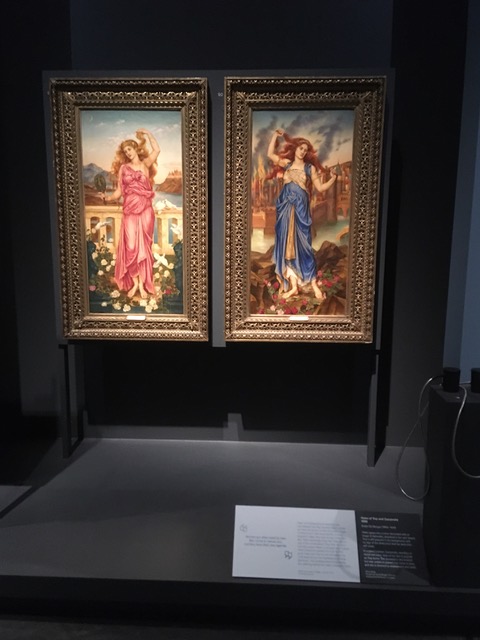Helen of Troy and Cassandra (both painted 1898) by Evelyn De Morgan are key pictures in her oeuvre which depict two women who were central to myths surrounding the fall of the ancient city of Troy.
According to the myth – made popular through Homer’s Illiad – Paris, the son of the King of Troy, was asked by meddling Gods to choose the fairest from Aphrodite, Hera, and Athena. He chose Aphrodite, goddess of love, who rewarded him with the fairest woman in the world. This was Helen, wife of Menelaus, Greek King of Sparta, who Paris promptly fell for and kidnapped. He sailed her to Troy, where she remained for 10 years whilst her husband fought bloody battles between the Greeks and Trojans to win her back.
The crux of the story is the devious king Menelaus’ Trojan Horse, which was supposedly left outside the walls of Troy as a gift. When it was wheeled into the city, the Spartans burst from it and burnt Troy to the ground. Cassandra was a woman blessed with prophecy, but cursed so that no one would believe her. Thus, her warnings of the demise of Troy were ignored.
The battles may have been caused and fought by armies of men, by Evelyn De Morgan celebrated the female mortals’ stories of the siege, offering a feminist alternative to the classical tale.
Both pictures are brimming with symbolism. Helen is surrounded by a garland of blushing pink roses, accentuated by her billowing pink robes and rose bud lips, demonstrating the allure of her beauty. She gazes into an ornate mirror, to represent vanity and reflection, there is a sadness in her knowing that she must be judged for her beauty alone and the dire consequences this might bring. Doves surround her, a nod to the peace and purity of her involvement. Cassandra, on the other hand, marches forward in a wild rage, furious her prediction was disbelieved and Troy burns to the ground. Behind her, the Trojan Horse can be seen on the city wall, verifying that her prediction was correct. Her dress is made of flames, indicating the prophecy was ethereal and burnt to an ember as her people refused to believe her, much like the city now burns around her.
These pictures were painted as a pair and intended to be displayed together, as they now are in the British Museum’s exhibition ‘Troy: Myth and Reality’, where they are central pieces in the discussion around the factual and imagined history of Troy.
The paintings were originally commissioned by William Imrie, a Scottish shipping magnate who was the Chairman of the White Star Line, which owned the Titanic. He lived near Liverpool and filled his Merseyside home, Sudley House, with modern paintings, including seven in total by Evelyn De Morgan. Upon the sale of his estate in the 1907, the pictures were separated for a number of years before Helen of Troy was purchased by the artist’s sister, Wilhelmina Stirling, for the De Morgan Collection in 1919.






